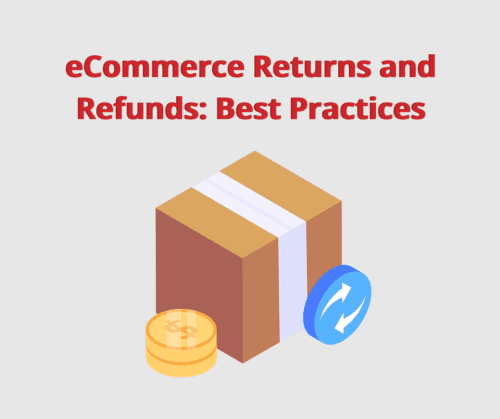Inventory management holds unique challenges for eCommerce companies. In many cases, your products go straight from factory to eCommerce fulfillment warehouse to the customer. However, with a well-crafted inventory management plan, you can improve your operations and increase your profits.

Essential elements of an inventory management plan
When you’re ready to create your inventory management plan, start with some basic data and tools.
Sales history
Your sales history from past years isn’t the only factor in your inventory management plan, but it’s one of the most vital. Sales data will help you understand seasonality and other factors that affect how much inventory you need.
The data should be in a spreadsheet or database that you can use to visualize your inventory flow. Match that with data on stock levels in your warehouses to give you even greater insights.
Cycle time and lead time
Cycle time is the time it takes to manufacture your items. Customer lead time is the time it takes to fill an order from the moment the customer completes checkout to when the carrier delivers their package. A realistic assessment of the cycle time and customer lead time is crucial to developing a successful inventory strategy that gets products on the shelves in time to meet customer demand.
To accurately calculate cycle time and lead time, be sure to give yourself an extra margin for potential supply chain disruptions.

Inventory costs
A benefit of inventory planning is improved profitability. To increase your margins, you need to understand all the costs associated with your inventory. These include:
- Fixed inventory costs include warehouse overhead or minimum monthly 3PL services fees. If you outsource your fulfillment to a 3PL with a variable fulfillment cost model, you might have minimal fixed inventory expenses.
- Variable inventory costs include monthly cubic foot storage costs. Your cost of goods sold will also vary depending on your stock levels and includes raw materials and manufacturing expenses.
- Holding cost is the cost of keeping inventory on the shelf. The longer a product sits unsold, the greater its holding cost and the lower your profit on that item. The price of holding stock can include monthly warehousing fees, interest, and insurance. Lean inventory management is a strategy that minimizes holding costs.
- Shortage costs are the extra expenses caused by backorders. These may include rush charges on fulfillment and shipping.
Inventory forecasting
Inventory forecasting is your first step in creating an inventory management plan. Using data from past sales, an inventory forecast estimates how much stock you will need during the next quarter or year and when you will need it.
Economic order quantity
Economic order quantity is a formula that uses your inventory forecast to calculate when you need to reorder. The calculation factors in the demand rate, or how fast your items sell, with inventory costs. EOQ can be very useful, but it’s based only on past sales. Dynamic inventory planning needs to incorporate a prediction of future demand as well.
Demand planning
Demand forecasting or planning takes your inventory management plan one step beyond inventory forecasting based on past sales. These demand forecasts often incorporate outside factors, such as economic outlooks and industry forecasts, to help you make better decisions about future stock levels.

Benefits of a successful inventory management plan
Inventory planning is essential to building a thriving eCommerce business. Here are just a few of the benefits of creating and following an inventory management plan.
Fewer backorders and stockouts
Stockouts can cost you more than sales. If your customers turn to one of your competitors when you are out of stock, they might never return. And, since online shoppers place a high value on fast delivery, backorders can lead to negative reviews and angry customers.
When you understand the timing of your supply chain and plan your inventory carefully, you reduce backorders and stockouts. As supply lines continue to suffer, a robust inventory management plan can give you an advantage over the competition.
Better cash flow
Every product sitting on a warehouse shelf holds a piece of your capital. Lean inventory management with high product turnover frees up your cash for use on marketing, promotions, and other business development projects. Inventory management planning is vital to increasing turnover and improving cash flow.
Eliminate zombie inventory
Zombie inventory or dead stock are the products that don’t move and gather dust on warehouse shelves. They might be out of date or out of fashion, and they’re costing you money. A plan to move zombie inventory through discounts, resale, or donation, is a critical benefit of inventory planning.
Increase profitability
When you hold too much stock, holding costs cut into your profit margins. If you don’t have a plan to get inventory to the fulfillment center in time to meet demand, you will lose sales. Smart inventory management will help you keep your stock moving and increase your profits.

Principles of inventory planning
It’s essential to understand that inventory planning is about much more than the timing and quantity of ordering products. It’s essential to consider every aspect of your supply chain in your inventory management.
Start with raw materials
Finished goods aren’t the only element of your supply chain that needs inventory management. Managing and tracking the flow of raw materials is essential to controlling costs and timing production. Extend your inventory planning process to include raw material controls.
Include manufacturing and warehousing
Bring your factory and warehouse managers into your inventory planning process. Their expertise will improve your plan, and including them from the beginning adds them as partners in executing your inventory management plan. Supply chain visibility is essential to successful inventory planning.
Plan warehouse locations
Your fulfillment warehouse locations are critical to your inventory plan. You want to place your stock close to your customers to reduce shipping zones, which reduces shipping costs and delivery times. But the more you divide your inventory, the more stock you have to carry and the greater the chance of stockouts.
Every warehouse in your fulfillment network adds a layer of complexity to your inventory planning. Look at the pros and cons of your inventory distribution and plan for the smallest number of national fulfillment locations that will give you the fastest delivery.

Refine and readjust your inventory management plan often
Your inventory management plan shouldn’t be a static document. Plan to revisit it at least every quarter. Check your projections against actuals to see how close your plan is to reality. Adjust your plan so you don’t carry forward errors into the rest of your planning period.
Physical inventory is a vital check on your inventory management. Plan to do spot checks to make sure your recorded inventory matches what’s on the shelf.

Obstacles to implementing your inventory management plan
Many eCommerce businesses struggle with inventory management. If you understand the obstacles before you get started, you’ll be better prepared to overcome them.
Insufficient data
Perhaps your sales and inventory data aren’t in a format that allows easy analysis. Or some records are missing, leaving gaps in your history. For startups, you might have only projections and no historical sales to use for reference.
Don’t let a lack of data stop you from creating an inventory management plan. Any plan is better than none, and your forecasts will become more accurate as you manage your inventory more actively.
Lack of resources
Online retailers often operate on a shoestring, making it hard to allocate staff time to all the tasks necessary for inventory planning. However, this aspect of your business is too important to neglect. If your staff doesn’t have time for inventory management, consider hiring an outside consultant to develop the plan with you. That gives you the added benefit of getting expert help to create your inventory management plan. And, when you calculate your savings from improving your inventory management, it is likely to more than offset the extra expense.
Untracked warehouse shrinkage
Shrinkage can undermine the best inventory management plan. Shrinkage is the stock that goes missing or gets damaged in the warehouse. Items can show up in your electronic stock count that don’t exist on the shelf. While manual counts can help quantify shrinkage, it’s best to work with a 3PL that provides fulfillment accuracy guarantees, including zero shrinkage.

You don’t have to tackle inventory planning alone
Inventory planning may seem like an overwhelming task. Fortunately, you don’t have to do it alone.
First, there are many inventory management software platforms to choose from. Apps can automate some of your inventory planning tasks, like forecasting and EOQ calculations.
Next, since software alone is not enough to create a top-notch inventory management plan, get help from your fulfillment partner. Your 3PL has experience with inventory turnover, warehouse management, and customer lead time. Lean on their expertise to help you craft a winning inventory management plan.
At Red Stag Fulfillment, helping our clients succeed is part of our mission. If you have questions about inventory management or any other aspect of eCommerce fulfillment, please reach out.
More about inventory management planning:







